|
Roadways
When designing roadways within developments, a determination should be made whether streets will be dedicated to the local jurisdiction (e.g., municipality, county) and therefore be designed to comply with road commission or municipal engineer standards or whether the roads will remain private. In both cases, local jurisdictions should encourage the use of the narrowest roads possible that still meet local health and safety requirements.
|
|

Narrow street in the New Neighborhood, Empire, Leelanau County
|
|
Benefits of Narrow Streets
Employing narrower streets provides a variety of advantages to project developers and future residents, as well as community members. These include creation of human-scaled neighborhoods, slower traffic speeds, lower construction and maintenance costs, more compact use of land, and reduced stormwater runoff volume.
Roadways vary throughout Northern Lower Michigan, and one-size road standards do not necessarily apply in all situations. Many local road and zoning standards require wide residential streets – even in rural areas. To preserve the regional character, as well as minimize stormwater runoff by reducing the amount of impervious surfaces, local jurisdictions and road commissions should consider revising current road standards to provide more flexibility when designing street widths and establishing rights-of-way.
|
|
|

|
|
Streets & Street Networks
Streets should be designed to complement a site’s natural topography and facilitate ingress and egress. Although traditional town grids make efficient use of limited land resources and can be easily integrated into an existing road system, alternative circulation patterns may prove useful for sites with significant topographic changes or other distinctive natural features. These include curvilinear, “T” (i.e., a visual termination at a key structure or landscape element), crossroads (i.e., two intersecting roads), common (i.e., a square in the middle), modified grid (i.e., combination of “T” and crossroads), and composite (i.e., a hodge-podge of all the street designs).
Design roadways to provide for current and estimated traffic flows without over-building. The incorporation of roundabouts (i.e., circles) in lieu of stop signs or traffic lights whenever possible facilitates traffic flow. Streets should also include bicycle lanes or a separate trail if a network already exists: their design should include street trees and other elements. Refer to Critical Design Practices: Streetscape for additional information.
|
|
|
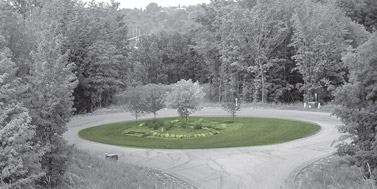
Cul-de-sac at Grayhawk, Garfield Township, Grand Traverse County
|
|
Cul-de-sacs (i.e., courts) & Turnarounds
A site’s design should minimize the use of cul-de-sacs since they increase travel times and concentrate traffic flow at a single point. Cul-de-sacs nonetheless offer a design option for low-density sites with unique natural landscape features or for cluster developments. Whenever possible, cul-de-sacs and turnarounds should have landscaped islands.
|
|
|

|
|
Alleys
Alleyways are important elements in several of the region’s communities. They foster a positive neighborhood space by providing services, parking, and utilities in a narrow width. Not only do alleys minimize the impact of driveways and garages on streetscapes, they provide additional on-street parking where driveway entrances would ordinarily be located. Alleys offer safer areas for children to play street games, as well as keep streets clear for snowplowing, emergency access, deliveries, waste collection, and other wide vehicles.
|
|
|
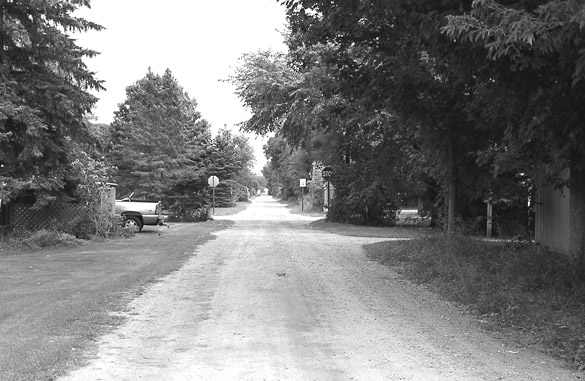
Unpaved alley in Mancelona, Antrim County
|
|
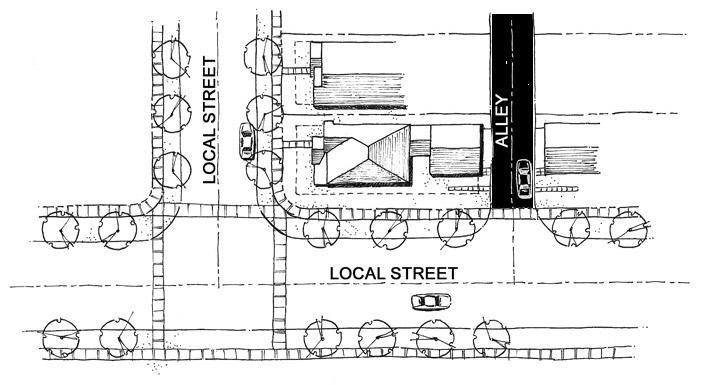
|
|
Traffic Calming Devices
Incorporate various traffic calming elements into the design of local streets to encourage slower speeds. Options include: chicanes, chokers, neckdowns, raised crosswalks, center island narrowings, and textured pavements. Refer to Appendix: Glossary for specifics on each technique.
|
|
|
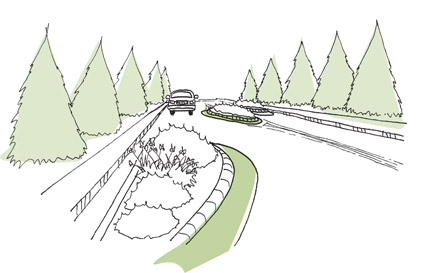
Curb extensions create a chicane
|
|
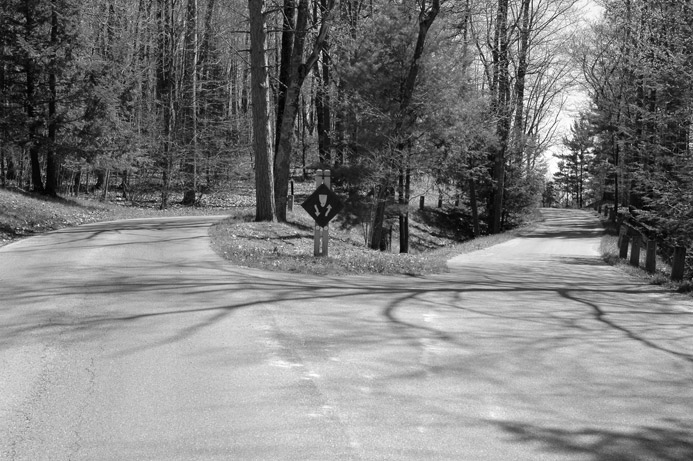
Boulevard strip slows traffic at The Homestead, Leelanau County
|
|
Key Points:
- Reduce road widths to reduce runoff and slow vehicle speed and downsize rights-of-way to minimize the impact on the natural landscape while still permitting safe, efficient vehicular and pedestrian circulation and sufficient emergency vehicle access.
- Vary rights-of-way for different streets with the widest for arterials and the narrowest for quiet residential streets.
- Street networks designed with multiple connections and relatively direct routes allow for emergency service access and shorter vehicular trips.
- Block length should be approximately two hundred (200) to four hundred (400) feet; block depth depends on the proposed land use and whether a mid-block alley will provide additional access.
- Through streets should be no more than a half mile apart.
- A cul-de-sac’s maximum length should be four hundred (400) feet with a minimum turning radius of thirty (30) feet. If local emergency vehicles require larger turn-around radius, alternatives (e.g., loop roads) should be employed.
- Local jurisdictions should encourage the use of alleys in new small-lot single family houses, town houses, and multi-lot developments.
- Recommended alley rights-of-way are twenty (20) to thirty (30) feet with a ten (10) to eighteen (18) foot pavement width.
- Design alleys to have two (2) or three (3) access points for emergency vehicle ingress and egress.
- Establish building setbacks a minimum of five (5) feet from an alley, and locate utilities underground.
- Use alleys to provide access to driveways, garages, and parking areas.
- Chicanes: alternating curb extensions form S-shaped curves that slow traffic.
- Chokers: mid-block curb extensions that narrow a roadway by widening a sidewalk or planting area.
- Neckdowns: curb extensions at intersections that reduce roadway width and shorten pedestrian crossing distance.
- Raised crosswalks: speed tables that provide pedestrians with a level street crossing.
- Textured pavements: surfacing materials that emphasize pedestrian crossings and intersections.
|
|
